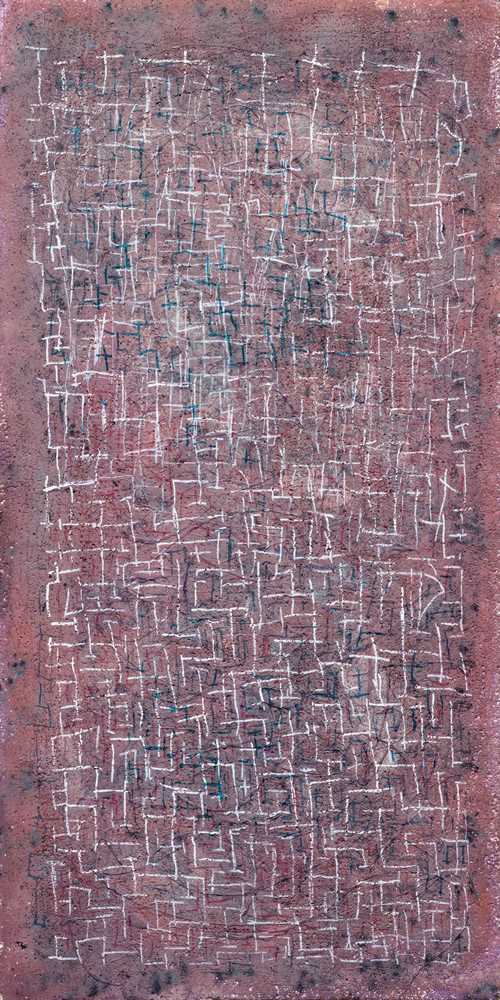
Lot 3426 - A201 PostWar & Contemporary - Thursday, 30. June 2022, 05.00 PM
MARK TOBEY
(Centerville 1890–1976 Basel)
Untitled. Ca. 1970.
Tempera on styrofoam.
Signed on the reverse: Tobey, as well as with the artist's stamp.
99.6 × 49.7 cm.
Gutachten:
[Art.ArtText.Text@@1('[Art.BoId],21')]
[Art.ArtText.Text@@1('[Art.BoId],21')]
Provenienz:
[Art.ArtText.Text@@1('[Art.BoId],22')]
[Art.ArtText.Text@@1('[Art.BoId],22')]
Ausstellungen:
[Art.ArtText.Text@@1('[Art.BoId],23')]
[Art.ArtText.Text@@1('[Art.BoId],23')]
Ausstellung:
[Art.ArtText.Text@@1('[Art.BoId],24')]
[Art.ArtText.Text@@1('[Art.BoId],24')]
Literatur:
[Art.ArtText.Text@@1('[Art.BoId],25')]
[Art.ArtText.Text@@1('[Art.BoId],25')]
[Art.ArtText.Text@@1('[Art.BoId],26')]
With the confirmation of authenticity by the Committee Mark Tobey, Münster, 28 February 2022. The present work is registered there under the number: 28/02/22-70.35. We thank Dr. Heiner Hachmeister for his kind assistance.
Provenance:
- Galerie Carzaniga, Basel.
- Purchased from the above at Art Basel 2001 by the present owner, since then private collection Switzerland.
White lines in movement symbolize a unifying idea which flows through the compartmented units of life bringing the consciousness of a larger relativity." Mark Tobey
The painter, poet and composer Mark Tobey was an important pioneer of Abstract Expressionism. His pictorial world is complex and is characterised by an almost inexhaustible potential for creativity, experimentation, and the power to innovate. With his distinctive approach to abstraction and his fusion of elements of Western modernism with components of Far Eastern calligraphy, Tobey created something new and radiant. Tobey’s complex oeuvre ranges from figurative works to the iconic White Writings. His works are exhibited in notable museums around the world.
The present work, created around 1970, features an internal structure of dynamic white, blue, and violet lines, together with scattered, intertwined calligraphic elements in a dark violet tempera impasto. The viewer searches in vain for a centre in this outstanding work. It is the entire painting that pulsates and is engulfed in optical rhythm and musical vibrations.
Painting on polystyrene — as in the work presented here — represented a particular challenge for Tobey because of the dullness and resistance of the material. This brilliant composition reveals the broad spectrum of Tobey's themes and interests: nature, civilisation, cities, movement, the sky and the cosmos, emptiness and contemplation, and rhythm and music.
Mark Tobey was born in Centerville, Wisconsin in 1890. From 1906 to 1908 he attended courses in oil and watercolour painting at the Art Institute in Chicago. In 1911 Tobey moved to New York, continued to teach himself painting and drawing, and earned his living as a fashion illustrator, portraitist, and caricaturist. From the time of his conversion to the Bahai faith in 1918, the meditative scriptural exercises and pictorial worlds of the Far East increasingly influenced his compositions. From 1925 Tobey began to travel, with visits to Paris and the Middle East. A longer trip took Tobey to China and Japan, where he closely studied Zen teachings and painting, as well as calligraphy, in a Zen monastery. From the 1940s onwards, Tobey produced his famous White Writings, which present a network of fine marks inspired by calligraphy. Tobey's international breakthrough came in 1958 when he won the International Prize for Painting at the Venice Biennale. Although Mark Tobey never lost contact with the country of his birth, he finally moved to Basel in 1960, where he died in 1976.
Provenance:
- Galerie Carzaniga, Basel.
- Purchased from the above at Art Basel 2001 by the present owner, since then private collection Switzerland.
White lines in movement symbolize a unifying idea which flows through the compartmented units of life bringing the consciousness of a larger relativity." Mark Tobey
The painter, poet and composer Mark Tobey was an important pioneer of Abstract Expressionism. His pictorial world is complex and is characterised by an almost inexhaustible potential for creativity, experimentation, and the power to innovate. With his distinctive approach to abstraction and his fusion of elements of Western modernism with components of Far Eastern calligraphy, Tobey created something new and radiant. Tobey’s complex oeuvre ranges from figurative works to the iconic White Writings. His works are exhibited in notable museums around the world.
The present work, created around 1970, features an internal structure of dynamic white, blue, and violet lines, together with scattered, intertwined calligraphic elements in a dark violet tempera impasto. The viewer searches in vain for a centre in this outstanding work. It is the entire painting that pulsates and is engulfed in optical rhythm and musical vibrations.
Painting on polystyrene — as in the work presented here — represented a particular challenge for Tobey because of the dullness and resistance of the material. This brilliant composition reveals the broad spectrum of Tobey's themes and interests: nature, civilisation, cities, movement, the sky and the cosmos, emptiness and contemplation, and rhythm and music.
Mark Tobey was born in Centerville, Wisconsin in 1890. From 1906 to 1908 he attended courses in oil and watercolour painting at the Art Institute in Chicago. In 1911 Tobey moved to New York, continued to teach himself painting and drawing, and earned his living as a fashion illustrator, portraitist, and caricaturist. From the time of his conversion to the Bahai faith in 1918, the meditative scriptural exercises and pictorial worlds of the Far East increasingly influenced his compositions. From 1925 Tobey began to travel, with visits to Paris and the Middle East. A longer trip took Tobey to China and Japan, where he closely studied Zen teachings and painting, as well as calligraphy, in a Zen monastery. From the 1940s onwards, Tobey produced his famous White Writings, which present a network of fine marks inspired by calligraphy. Tobey's international breakthrough came in 1958 when he won the International Prize for Painting at the Venice Biennale. Although Mark Tobey never lost contact with the country of his birth, he finally moved to Basel in 1960, where he died in 1976.
CHF 55 000 / 75 000 | (€ 56 700 / 77 320)
Sold for CHF 67 400 (including buyer’s premium)
All information is subject to change.

